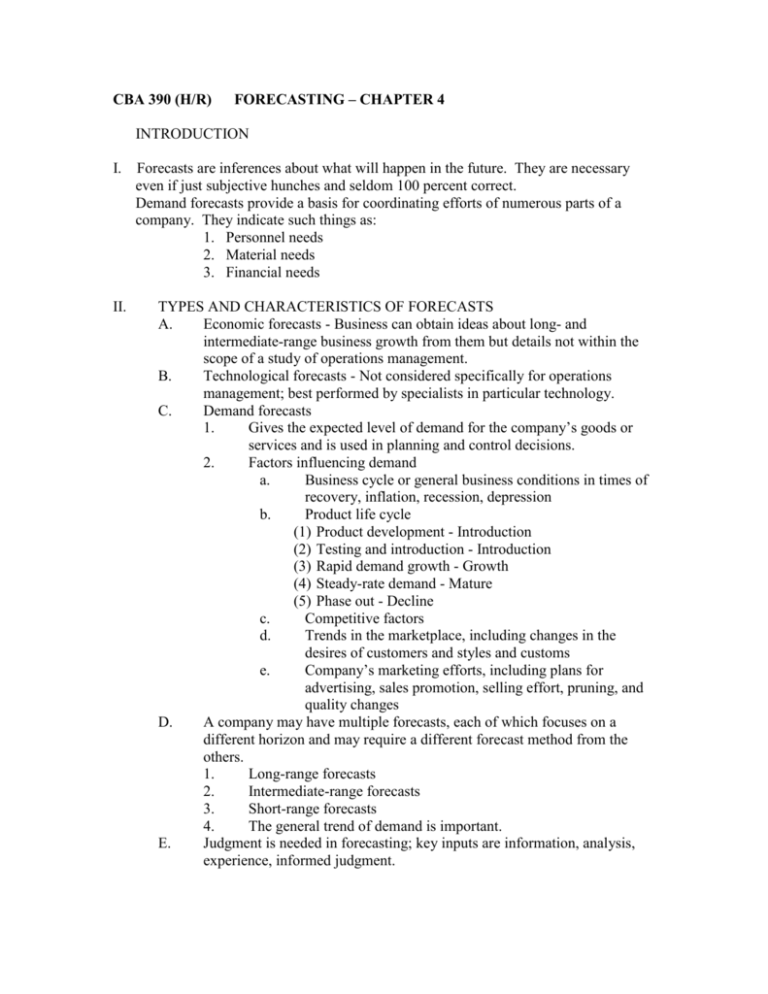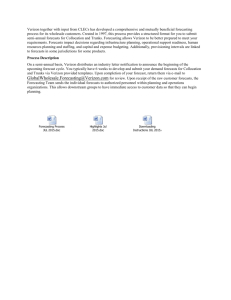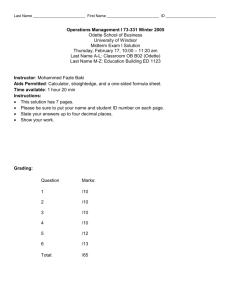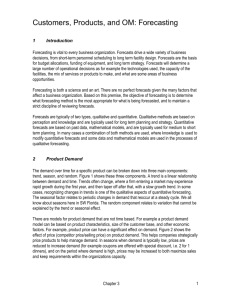Chapter 4 Outline
advertisement

CBA 390 (H/R) FORECASTING – CHAPTER 4 INTRODUCTION I. II. Forecasts are inferences about what will happen in the future. They are necessary even if just subjective hunches and seldom 100 percent correct. Demand forecasts provide a basis for coordinating efforts of numerous parts of a company. They indicate such things as: 1. Personnel needs 2. Material needs 3. Financial needs TYPES AND CHARACTERISTICS OF FORECASTS A. Economic forecasts - Business can obtain ideas about long- and intermediate-range business growth from them but details not within the scope of a study of operations management. B. Technological forecasts - Not considered specifically for operations management; best performed by specialists in particular technology. C. Demand forecasts 1. Gives the expected level of demand for the company’s goods or services and is used in planning and control decisions. 2. Factors influencing demand a. Business cycle or general business conditions in times of recovery, inflation, recession, depression b. Product life cycle (1) Product development - Introduction (2) Testing and introduction - Introduction (3) Rapid demand growth - Growth (4) Steady-rate demand - Mature (5) Phase out - Decline c. Competitive factors d. Trends in the marketplace, including changes in the desires of customers and styles and customs e. Company’s marketing efforts, including plans for advertising, sales promotion, selling effort, pruning, and quality changes D. A company may have multiple forecasts, each of which focuses on a different horizon and may require a different forecast method from the others. 1. Long-range forecasts 2. Intermediate-range forecasts 3. Short-range forecasts 4. The general trend of demand is important. E. Judgment is needed in forecasting; key inputs are information, analysis, experience, informed judgment. III. GENERAL APPROACHES TO FORECASTING A. Qualitative forecasting methods (subjective) 1. Sales force composite 2. Jury of executives opinion 3. Consumer market survey 4. The Delphi method B. Quantitative forecasting (objective) 1. Time series models a. naïve approach b. moving average c. exponential smoothing d. trend projection 2. Associative model (causal model) - linear regression 3. Components of a time series (trend, seasonal, cyclical, random) IV. STEPS IN THE FORECAST SYSTEM 1. Determine use of the forecast 2. Select items to be forecasted 3. Determine the time horizon 4. Select the forecast model 5. Gather data 6. Make the forecast 7. Validate and implement the results V. MEASURES OF FORECAST ACCURACY A. Mean absolute deviation B. Mean square error C. Mean forecast error D. Mean absolute percentage error VI. CASUAL MODELS - Regression methods - Simple linear regression is used to find the independent variable that best predicts demand. a. Coefficient of linear correlation b. Coefficient of determination c. Standard error of the estimate VII. THE USE OF COMPUTERS IN FORECASTING Reduces work and time in evaluating models and making forecasts VIII. MONITORING AND CONTROLLING FORECASTS A. Use of tracking and adaptive smoothing B. The technique of adaptive smoothing








